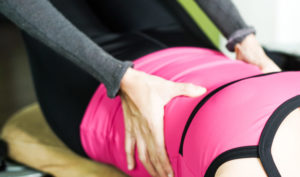This is the 2nd part of the deep core activation-from your ribs.
Review of the anatomy. You have 4 layers of abdominal muscles, from the deepest(deeper inside to your body) to the most superficial, transverse abdominis, internal oblique, external oblique, and rectus abdominis(the one you can see on your abs, commonly known as 6 packs but you actually have 10 of them).
Fun fact: Your transverse abdominis does not ‘move’ your torso when it’s ‘at work’. It is turned on 24/7 even during your sleep, like noises in the background. They will activate according to the loads you put on them, low load(low activity level) means this muscles does not have to work as hard as if you are trying to lift heavy weight, for example.
When you deep core is not functioning well, due to past injuries, surgeries, or sedentary lifestyle, you may start to get back pain. This is why the first thing we do in Pilates is to get you to ‘engage’ your core.
The coverage of this muscles is bigger than you think. It attaches onto the lower rib, your low back and into your pelvis in the front, you can see it as a 3 dimensional muscle, much like a ‘corset” supporting you mid section.
So what do you do to make sure this guy is working? Do not pull in your navel. Instead, put your fingers 2″ away from your hip bones, and pull that part of your abs in gently with exhale. This action should not change the position of your pelvis(hip) or spine(back)(see video in Part 1 of this article).
The next piece to that is to connect the bottom of your ribs below your chest, during exhalation(see video in this article).
When you put these two actions together, you may feel a slight activation in your low back muscles and eventually feel this muscles pulling in from front, back, and two sides, like your are wearing a ‘corset’.
If you feel that your deep core is not working optimally, practice these two techniques daily for 2-3 weeks. You can do them in any position-standing, sitting, lying down etc. Remember to keep your spine elongated when you do it, and do them GENTLY.
It is important that you learn the correct technique when you begin any core exercises, our teachers are experts in guiding and getting the best results. We love to hear from you so contact us now!
~Sook Fun

